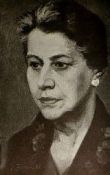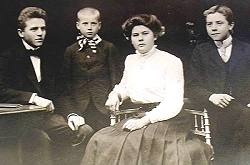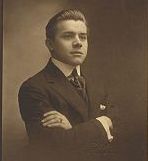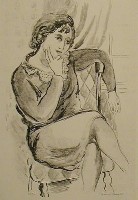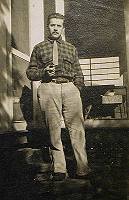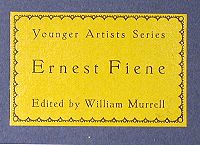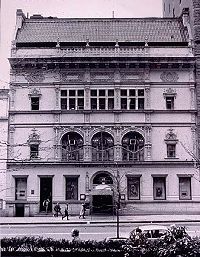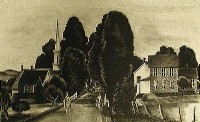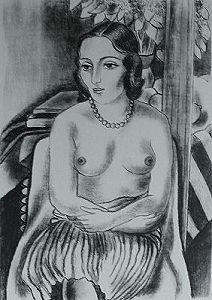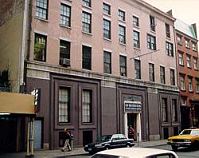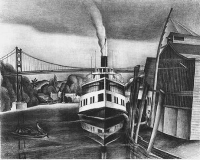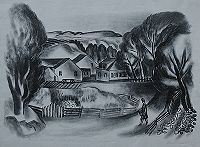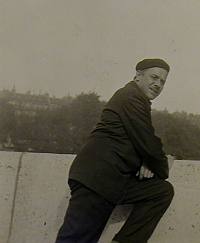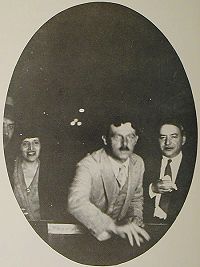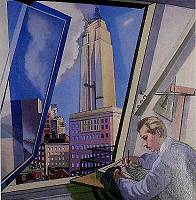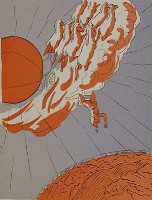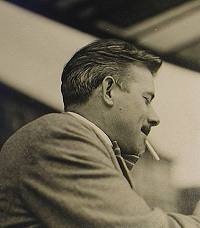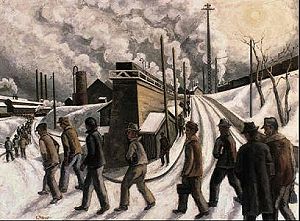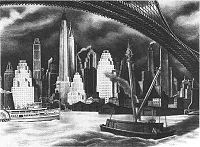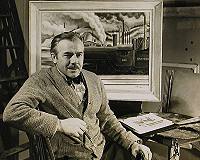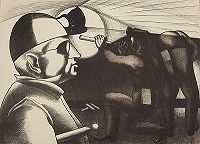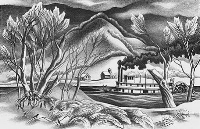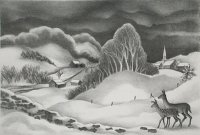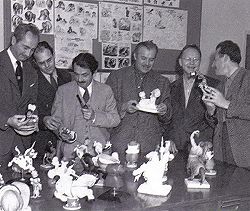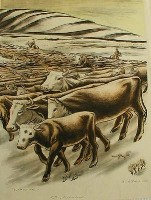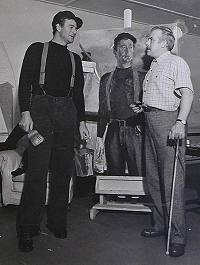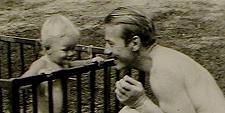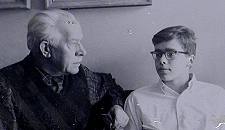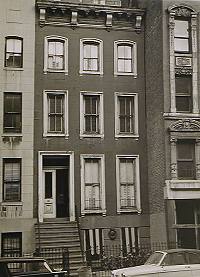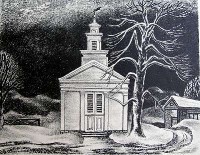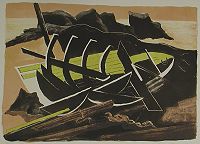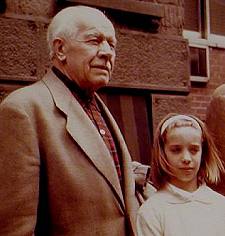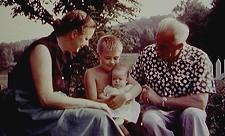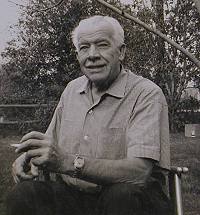| Fiene Quintanilla Online Catalogue Raisonné Project Home || About FQOCRP || Contact Us || Search the Site |
|
A Chronology of Ernest Fiene's Life | The Prints of Ernest Fiene: A Catalogue Raisonné in progress |
|||||||||||||||||||||||
|
1894-1920
|
|||||||||||||||||||||||||
|
1894: Born Elberfeld, Rhineland, Germany, November 2, son of Henry and Maria (Egger) Fiene. 1906: At only twelve years of age, he gives evidence of a definete artistic talent; . . .by beginning "the serious study of the works of the early German artists, expecially Albrect Durer, the sixteenth century master of etching, woodcut and engraiving. He also studie[s] the watercolor medium as exemplified in the work of the early Chinese painters" (Handbook of the American Artists Group 30). c. 1908: Begins an apprenticeship in mining construction with the idea of going into engineering as a profession. 1912: Flees Germany to Holland to avoid conscription into “the Kaiser’s Army,” and continues on to the United States settling in New York City, working in various jobs including assistant to a decorative painter (Woodstock’s Art Heritage., 86). 1914-1918: Studies at the National Academy of Design, New York City--during 1914-15 in Leon Kroll's night class and then in Thomas Maynard's day class from 1915-1918. Famously, he never finishes a picture during this period of study (Linda Hyman, "Ernest Fiene, Art of the City"). 1916-1918: Studies at Beaux Art Institute, New York City. 1919: Has first exhibition appearance showing five watercolors at the McDowell Club of New York--arranged for him by Robert Henri, a major influence on his work. Attends lectures by William Merritt Chase at the Metropolitan Museum of Art, and also counts him as an important early influence. |
|
||||||||||||||||||||||||
|
1921-1925
Return to the top of this page. |
|||||||||||||||||||||||||
|
1920: Exhibits with the Society of Independent Artists. Maintains a New York City residence at 9 East 59th Street (According to Marlor). Moves to Woodstock, NY, at least for part of the year, painting mostly landscapes of the surrounding Ulster County country side, as well as still lifes and figure studies. 1921: Marries Jeanette Etarre in New York City on September 8. 1922: William Murrell writes monograph “Ernest Fiene” for Younger Artists Series (published in Woodstock, NY)--an important early source of recognition. The volume includes one color reproduction and twenty-seven b/w reproductions of Fiene paintings along with Murrell's essay. The Fiene volume was the first in the series followed by Alexander Brook, Peggy Bacon, and Yasuo Kuniyoshi. (Murrell, "Ernest Fiene"). Maintains New York City residence/studio at 5 West 16th Street (According to Marlor). Shows watercolors at the McDowell Club, NYC. 1923: Studies etching and lithography at the Art Students League, New York City. During this year etching and lithography classes at the league are directed by Joseph Pennell, and in the case of lithography he is aided first by the lithographic printer George C. Miller and then artist-lithographer Charles C. Locke (Adams, American Lithographers, 50). It is likely that it is in his classes at the League that his relationship with Miller, the printer for most of his lithographs throughout his life, begins. Eugene Fitsch, an artist Fiene knew and admired, also taught printmaking at the League beginning in 1923. Has his first one man show, held at the Whitney Studio Club (the precursor to the Whitney Museum of American Art), New York City. Maintains New York City residence/studio at 8 East 15th Street (According to Marlor). 1924: The New Gallery of New York City becomes his exclusive dealer and he has major one-man exhibition there of paintings, watercolors, drawings and etchings (Oct. 30- Nov. 15) and sells Fifty-two pictures -- a pivotal event in his career. Uses proceeds from this show to build a bungalow in Woodstock, next door to his brother, the sculptor Paul Fiene. (According to one source Ernest and Paul had built studios in Woodstock as early as 1920. (See Woodstock’s Art Heritage., 86). 1925: Shows oil paintings at the Stone International Gallery, Pasadena, California, and at the Boston Arts Club.
|
|
||||||||||||||||||||||||
|
1926-1929
Return to the top of this page. |
|||||||||||||||||||||||||
| 1926: Finds it necessary to seek a loan because he cannot afford a proper studio and adequate materials. His work can be found at three NYC galleries at this time: J. B. Nauman Gallery, Kraushaar Gallery, and the Rehn Gallery. In Boston, his work is shown at The Boston Arts Club.
Continues to have address at 8 East 15th Street, only a few blocks uptown from Greenwich Village, The Whitney Studio Club on 8th street and Washington Square Park. 1927: Shows painting Entrance to Village No. 2 at Whitney Studio Club Auction on March 10. (See lithograph Entrance to Village, the edtition of which is dedicated to Julianna R. Force, first director of the Whitney. In April has address at 19 E. 9th Street, NYC, around the corner and across Fifth Ave. from the Whitney Studio Club at 8 West 8th Street, which in 1931, through the patronage of Gloria Vanderbilt Whitney, becomes the first site of the new Whitney Museum of American Art. Julianna R. Force, the director of the Whitney Studio Club and later first director of the Whitney Museum of American Art (WMAA), writes to Fiene on April 6, that she would like his painting "'Hudson Navigation Boat' and maybe another of your things which you do this summer" for her upcoming exhibition, which must have "the best and the newest in every sense of the word" (Ernest Fiene Papers, Reel 1). Hudson Navigation Boat remains in the collection of the WMAA, a gift of Gertrude Vanderbilt Whitney. The lithograph Hudson River Boat (1928) portrays an image very similar to the painting. (To view an extensive article on Julianna R. Force, click here.) Travels to the Murray Bay section of French Canada painting, drawing. Some of these drawings become studies for lithographs French Canada and Canadian Village. These works along with images of the Hudson River and New York City characterize his oeuvre of the period. Illustrates Phillida and Coridon and Other Pastorals (drawings in color), text by Nicholas Breton, The Spiral Press, New York City, which becomes one of the “Fifty Books of the Year”; Kraushaar becomes his dealer in New York. Has "Exhibition of Paintings Drawings, Lithographs and Water Colors" at the C. W. Kraushaar Galleries (November 12-26) New York City. 1928: Has two man show (with Glenn O. Coleman) at the Whitney Studio Galleries. Begins affiliation with The Downtown Gallery, New York City, and has exhibition "Ernest Fiene New Lithographs," which runs from March 26 through April 15. Becomes naturalized citizen of the United States; sells three paintings (including Hudson Riverboat and Dyckman Street Church to the Whitney Museum of American Art; sells house in Woodstock. Painting Girl with the Black Hat is exhibited at the Art Institute of Chicago. 1928-29: Arrives Paris in December, 1928, and commences studies in Montparnasse at L’Academie de La Grande Chaumiere; paints mostly figure studies in Paris and watercolors on a visit to Brittany. Having brought some of his New York Drawings with him to Paris, he becomes convinced New York is the city he prefers as subject for his urban art. Makes lithographs at Atelier Desjobert, Paris, including Brooklyn Bridge. (See topic gallery: Prints with a French Connection.) While in Paris he socializes with artist friends from Woodstock including Emil Ganso, John Taylor, and Arnold and Lucile Blanch and meets Braque, Derain, Foujita and other School of Paris figures at Montparnasse bars such as La Coupole. Close relationships develop with artists Jules Pascin and Robert Laurent, with whom he had socialized in New York. For a while Pascin lends him his studio on the Boulevard Clichy, but it is the work of Matisse that makes the greatest impression on the artist, especially in the figure studies he executes in Pacin's studio. |
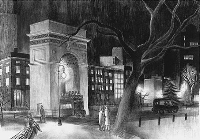 Washington Square No. 1 Lithograph 1928
|
||||||||||||||||||||||||
|
1930-1933
Return to the top of this page. |
|||||||||||||||||||||||||
|
1930: Has important show in February at the F. K. M. Rehn Gallery, New York City, of oils, watercolors, drawings and lithographs. Shows oil paintings at the Chicago Arts Club. 1930-31: Teaches drawing, painting and etching at the Westchester County Center, White Plains, NY. 1930-33: Is chiefly occupied with a series of paintings of New York City, including Under Brooklyn Bridge . . . and the well known Changing Old New York series. This series included Fall of Old Houses (Also titled Razing Buildings, West 49th Street -- which Henri Matisse saw in an exhibition at the Museum of Modern Art entitled “Painting and Sculpture by Living Americans,” December 2, 1930--January 20, 1931, and called the finest picture he had seen in New York. (Linda Hyman, "Ernest Fiene, Art of the City"). His New York studio during this period and until late 1938 or early 1939 is at Two East 23rd Street just off Madison Square Park. During 1930 and early 1931, he would have been able to look through his window and view the Empire State Building rising ten blocks uptown between 33rd and 34th Streets on Fifth Avenue. (The Empire State Building was formally opened on May 1, 1931.) 1931: Has exhibition of paintings from his “Changing Old New York” series at the Frank Rehn Gallery in New York City in March. This show included the Razing Buildings painting as well as View from my Window in which he depicts himself drawing the lithograph Empire State Building on the stone. View from My Window also appears at the Carnegie International exhibition. 1932: His painting Nocturne, 34th Street is shown at the first Biennial Exhibition of American Painting at the Whitney Museum of American Art. Another painting Hudson River Boat appears in the exhibition "Eighty Years of American Painting" at the Museum of Modern Art during the same month. His prints are shown in exhibitions at the Downtown Gallery and the Weyhe Gallery, both important venues for contemporary New York painters and printmakers. Illustrates Phaeton, Son of Apollo, text by Joseph Gavorse, published by the Society of American Bibliophiles, New York City. The book is included in “Fifty Books of the Year” for 1932. (See Phaethon in the Stable and Fall of Phaethon.) Shows two mural studies at a MoMA mural exhibition in May but is later critical of this exhibition calling it “ridiculous”: “Why is it that those in the position to direct the destiny of the artist and of his work know next to nothing about the process of the creation of art. They do not realize that it takes months to work out a composition which may take only some weeks or days to execute in any size” (Letter to Edith Halpert, February 15, 1934, Ernest Fiene Papers, Reel 1) Receives Guggenheim fellowship for the period May 20-November 20. Uses it to spend the summer in Italy studying the old masters and then fresco painting in Florence. Upon receiving the award, comments, “I am interested more in the future of American art than in the past of European art. Out of this new civilization, out of this machine age, a new school of painters will be developed." (” New Rochelle Standard Star, March 23, 1932 -- quoted in Hyman). |
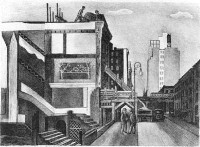 Razing Buildings, West 49th Street Lithograph 1932
|
||||||||||||||||||||||||
|
1933-1936
Return to the top of this page. |
|||||||||||||||||||||||||
| 1933: Work appears at the College Art International, Brooklyn Museum, Museum of Modern Art, Whitney Museum of American Art ("Exhibition of Paintings and Sculpture by Guggenheim Fellows"), and in the exhibition "Major Works by Distinguished American Artists" at the Downtown Gallery.
Has show of his lithographs at the Kleeman-Thurman[n?] Galleries, New York. Art News writes of this exhibition on Feb. 11, 1933, "Ernest Fiene is showing new lithographs at the Kleeman-Thurmann Galleries. . . . In these new prints he has fairly outdone himself. . . . He gets at the heart and soul of this town in his crisply defined visions of bridges and skyscrapers, and the two new Washington Square items are infused with a new grace and dignnity that puts them at the top of the list. His nudes are also invested with a new authority. . . ." No catalogue of this exhibition has been found but presumably some of these lithographs were shown previously at the Downtown Gallery exhibition of 1928. Purchases pre-revolutionary war home and “farm” in Southbury, CT, which becomes his out of New York City residence and studio through the late 1950's. Many of his winter scenes and churche pictures find their settings in the area of Southbury. (The house no longer exists.) 1934: Has one man show, "Recent Paintings" at the Downtown Gallery, New York City, (Jan. 3-Jan. 20) which includes his most well known and widely exhibited work of the period, New York Skyline. A larger version of the show is subsequently lent by the Downtown Gallery to the Arts Club of Chicago where it runs from February 16--March 6. Does book jacket illustration (a painting) for Sinclair Lewis novel Work of Art. He writes to Lewis thanking him for his inscribed copy and commenting that like the author, "It has been my aim to use in my painting the mateial and environment of our time to create a vital art with it." (unpublished letter from Ernest Fiene to Sinclair Lewis, Feb. 6, 1934, Ernest Fiene Papers, Reel 1) 1935: Colorado Springs [CO] Fine Arts Center invites Fiene to spend the summer teaching there; he accepts and along with teaching, has a show of oils and watercolors at the Center, paints in Colorado and New Mexico, including Taos and Santa Fe. He also exhibits for the month of August thirty paintings and watercolors presented by the Denver Art Museum in its gallery at the City and County Building. Denver Art Msueum purchases painting Connecticut Hills, Winter, for its permanent collection. Works as “art expert” for the Resettlement Administration, Washington, D. C. Spends December traveling through Pennsylvania and West Virginia painting industrial and mining scenes as well as “ghost towns," as he calls them. At least two prints derive from this journey, Mine Superintendent and Winter on the River. 1935-38: Chief undertaking is painting industrial subjects (coal and steel) from Pennsylvania and West Virginia settings. His painting of “The Lucy Plant” part of the Carnegie Steel plant in Pittsburgh is exhibited at the third Whitney Museum Biennial, 1936. (Hyman, fig. 7). Twenty-four of these paintings are presented at an exhibition “The Industrial Scene” in October, 1937 at the First National Bank in Pittsburgh and sponsored by the Pittsburgh Commission for Industrial Expansion, an intent of which is to attract more industry to the Pittsburgh region. Ironically, the radical Artists Union of Philadelphia exhibits some of these same paintings because they contain images that depict the harsh circumstances afflicting workers' lives. The title of one conte-crayon drawing is "Steel Mills and Slum Dwellings." (Reproduced in "New Deal Art WPA Works at the University of Kentucky" University of Kentucky Art Museum, 1985) An oil on canvas that was reproduced and widely distributed as a color photo-lithograph is pictured below.
1936: Completes the mural in oil, “Paul Revere as an Industrialist” for the Post Office, Canton, MA. Invites his student at the Art Students League, Alicia Wiencek, to assist him in work on mural commission for the new Department of the Interior Building in Washington, D.C. Both murals commissioned by the Treasury Department’s Section of Fine Arts. Completes his only print for the American Artists Group (AAG), Winter on the River, a scene derived from his winter journey through Pennsylvania and West Virginia. The artist comments that "it was a winter of many blizzards . . . . I traveled by car and although it was hazardous my enthusiasm for the strange visual beauty of the industrial regions blanketed in snow led me on. " (Current Biography p. 18) Has a lithograph (Winter Evening) published by Associated American Artists (AAA) for the first time. Between 1936 and 1953, ten more are to follow. (See AAG/AAA gallery.) |
 Residence in Southbury, Connecticut
|
||||||||||||||||||||||||
|
1937-1941 |
|||||||||||||||||||||||||
| 1937-40: Executes two Murals (Frescoes), with the assistance of artist and future wife Alicia Wiencek, on the history of the needle trades for the Central High School of Needle Trades (now the High School of Fashion Industries) at 24th Street and Eighth Ave. in Manhattan: “Victory of Light over Darkness” and “Harmony and Achievement” allegorical subjects, over 2000 square feet in total size. This becomes a 2 1/2 year project. The two murals at the High School of Needle Trades are unveiled in June and presented to the New York City Board of Education.
1937: Completes four oil on canvas murals, Placer Mining, Forest Fire, Reforestation, and “Cattle Round-up” (See entry for lithograph, 1938-39: Receives the W. A. Clark prize from the Corcoran Gallery, Washington, D.C. for his painting Spring Evening; teaches art at Cooper Union, New York City. 1939: Receives one of the five prizes to Americans given at the Carnegie International Exhibition for his painting Razing the Old Post Office (New York). 1939-42: First teaches at the Art Students League, New York City. 1939-43 (and possibly longer): Maintains a studio in Carnegie Hall ( #908). 1940: Has one of his largest one-man shows ever, a total of 53 paintings and watercolors, at Associated American Artists (AAA) from Jan. 23 - Feb.10. Most of the works were completed between 1935 and 1939. These include the first showing of the prize winners from the Art Institute of Chicago, The Carnegie International and the Corcoran Gallery mentioned above, as well as his new series of Adirondack watercolors. Receives yet another prize for his painting Razing the Old Post Office, the Ada S. Garrett Prize from the Art Institute of Chicago. Is one of fourteen American Artists, including Edward Hopper, Reginald Marsh, and Thomas Hart Benton to be selected for an exhibition in April of prominent contemporary painters at the Detroit Institute of Art. One of his five canvases, Toward Evening, Connecticut, is an image similar to the lithograph Colonial Village. Arrives Los Angeles May 14, and joins a group of eight other artists (See photos and captions below and at right.) invited by Reeves Lewenthal, president of Associated American Artists to paint scenes from the John Ford film “The Long Voyage Home.”
|
 Detail of Fiene mural, "Victory of Light over Darkness" (1937-39) depicting the Triangle Shirtwaste Fire (Image courtesy of New Deal Network)
Fiene went to Hollywood in the company of eight well-known American painters. "These included Grant Wood, George Schreiber, Luis Quintanilla, George Biddle, Thomas Hart Benton, Robert Philipp, Raphael Soyer, and James Chapin. They had all been brought together by Reeves Lewenthal, the director of the Associated American Artists' Gallery, who had made an agreement with Walter Wanger to have them paint scenes from the film Wanger was currently producing, The Long Voyage Home, an adaptation of four of Eugene O'Neill's shorter plays. [originally written between 1913 and 1917.] The movie was directed by John Ford and included his usual company of actors: John Wayne, Barry Fitzgerald, Ward Bond, and Thomas Mitchell among others. And each artist was to choose an aspect of the movie to paint with its cast serving as models. . . ." From Waiting at the Shore by Paul Quintanilla (For more information about this gathering of artists in Hollywood, visit |
||||||||||||||||||||||||
|
1941-1949
Return to the top of this page. |
|||||||||||||||||||||||||
|
1941: Is invited to join the art department of the State University of Iowa, Iowa City, to replace his recently deceased friend Emil Ganso, but declines the offer. 1942-45: Travels around the country painting scenes of industry and science (steel, oil, medicine, and optical instruments) in their relation to the war, such as “Oil Refinery # 1” at Baton Rouge, LA, and Glass Blower Team” at Corning, NY. Some of these are done on commission by corporations such as Abbott Laboratories and Standard Oil with the intent of showing how their products are related to wartime efforts; others are commissioned by the goverrnment. 1943: Has exhibition of "Winter Works," both rural and urban, at Associated American Artists (AAA) in New York (February-March 6). Included are paintings Deep Winter No. 1 and St. Michaels in Brooklyn, No. 1, both of which are related to lithographs of the period. (Click the painting titles to view the lithographs.) Creates presentation print Winter Sun for the Print Club of Rochester; appears November 10 at the Memorial Art Gallery to address the print club. 1945: Is divorced from Jeanette Fiene; marries Alicia Wiencek August 12, in Washington, Connecticut. 1946: Moves into 331 E. 55th Street, New York City, as early as September, while still retaining his residence in Southbury, Connecticut. This New York house, which he eventually will own, remains his primary residence and studio until the end of his life. His first child, Paul René, is born on September 4.
1948: Returns to the Arts Students League to teach Saturday classes in painting and drawing. 1949: Ceases relationship with Associated American Artists and Knoedlers becomes his dealer in New York. In a letter of February 25, Thomas Hart Benton writes to Fiene, “It was good to hear from you after all this time. It was better to hear you had finally cleared out of that house of corruption at 711 5h Ave. [The reference is to Associated American Artists gallery] and were prepared to start again. I don’t know much about Knoedlers but it is an old house with a respectable name and you won’t be made a fool out of there. . . .” (Benton had left AAA a few years earlier after a dispute with Reeves Lewenthal, its founder and director.) Has exhibition of 20 canvases at the Mattituck Museum of Art in Waterbury, Conn. that features Connecticut landscapes of the surrounding countryside that includes the area of his Southbury home. The local paper comments, "Mr. Fiene's work shows a tremendous enthusiasm for the Connecticut landscape, particularly its little towns and churches which he considers the purest type of of architecture and whose clean clear lines lend themselves to his deceptively simple style of painting" (Waterbury Republican, Feb. 13, 1949, p. 2). |
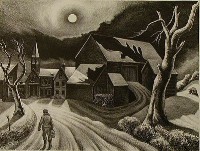 Winter Sun [1] Lithograph 1943
|
||||||||||||||||||||||||
|
1949-1958
Return to the top of this page. |
|||||||||||||||||||||||||
|
1949-64: Returns to the Art Students League, New York City to teach painting and drawing. 1950-51: Teaches art at the Ogunquit (Maine) School of Painting and Sculpture. Paints in various Maine locations including Monhegan Island. It is here that the more abstract series of works generally know as "The Wreck," on which he worked for many years, finds its setting. (Monhegan Island is a small island off the coast of Maine near Port Clyde. It was and remains an active artists colony.) 1951-53: Serves as president of Artists Equity Association, afterward is elected honorary chairman of the New York Chapter of Artists Equity. 1952: Tries to Sell Southbury property to the state of Connecticut because it is surrounded by State Training School 1952: Is elected Academician of the National Academy of Design (March 5). |
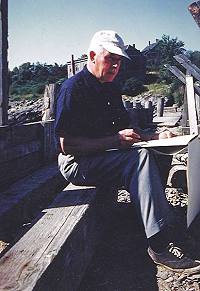 Drawing on Monhegan Island, Maine (1951) |
||||||||||||||||||||||||
|
1954: Daughter Maria Louise is born on April 5; Shows work at Skowhegan, Maine.
1954-55: Serves as director of the Tupperware Art Fund, a program set up by the manufacturer of plastic kitchenware to provide fellowships and other monetary awards to artists around the country who enter a competition. Artists must be citizens or permanent residents of the United States and awards will be made "without distinction of race, color, or creed." A stipulation for entrants is that paintings must deal with recognizable figures. Fiene engages his printer George C. Miller to make large edition reproductive color lithographs of some of his paintings for distribution through the Tupperware Art endeavor. 1955: Completes two murals, George Washington at Valley Forge and Thomas Jefferson Signing the Declaration of Independence, for Abraham Lincoln High School, Brooklyn, NY. 1955-1965: Is member of the supervising faculty of the Famous Artists School, Westport, CT. 1957: Sells residence in Southbury, Conn. which he has used as his country house since 1933; 335 E. 55th Street, New York becomes the family's sole abode. 1958: Tours Europe for month of April for Famous Artists School. |
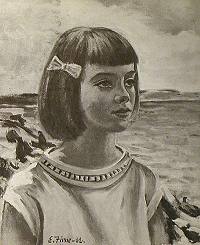 Portrait of Maria Louise, Oil on Canvas, 1962
|
||||||||||||||||||||||||
|
1959-1965
Return to the top of this page. |
|||||||||||||||||||||||||
|
1950's (mid) - 1960's: Serves as : Supervising Faculty, Famous Artists School, Westport, CT.; Director, Tupperware Art Fund, Orlando, FL,. 1959-1964: Teaches at the National Academy School of Fine Art, New York City. 1959: Exhibits, for the last time during his lifetime, a series of New York City works at the Midtown Galleries in Manhattan (Jan. 27-Feb. 21). Critics of the exhibition see the newer cityscapes as more abstract and more precisionist than those of his earlier periods. Carlyle Burrows of the New York Herald Tribune compares his new work to that of Charles Sheeler. Noted in catalogue as most recent show since one man show at Knoedler's in 1949. 1960: Travels through Europe during July and August, first on a tour, probably for Famous Artists School, then on his own in southern Italy, where he meets other artists in Positano. Expects Alicia to join him in Madrid in mid-August. Correspondence reveals Alicia's illness affecting travel plans. Unclear if she actually manages to make trip. 1961: Alicia Fiene (wife) dies on February, 17, 1961 in New York City. 1964: Publishes Complete Guide to Oil Painting (Watson-Guptill, New York). Laments to the director of Midtown Gallery the great disparity between the relatively low price of one of his paintings offered there compared to the prices of other painters handled by them, namely Edward Hopper and Andrew Wyeth. 1965: Travels to Paris to execute a series of color lithographs in the atelier of Edmond Desjobert (who himself had died two years earlier), the same print shop where he had made black ink lithographs in 1929. Dies of a heart attack in Paris on August 10, while making prints, in the company of his long-time artist friends Adolf Dehn and Federico Castellon at Desjobert's. Adolf Dehn's wife, Virginia Dehn, in a letter to Ernest Fiene's son Paul about the death of his father wrote the following:
|
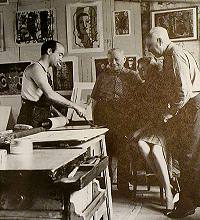 (Rt. to Lft) Adolf Dehn, Viginia Dehn and Edmond Desjobert looking on as a printer inks a stone, Desjobert's atelier in Paris early 1960's. (photo courtesy Minnesota Historical Society/ Virginia Dehn)
|
||||||||||||||||||||||||
| Return to the top of this page. | |||||||||||||||||||||||||
| This page last revised: |
|||||||||||||||||||||||||
